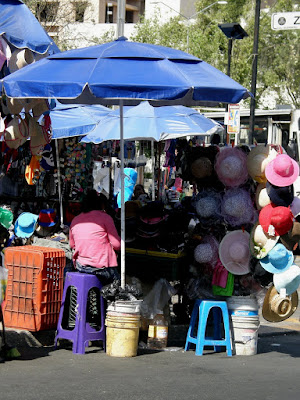We found ourselves walking in a section of the Historic District new to us. Unlike many streets where street-level facades have been 'modernized', the area around the Museum has not suffered this fate. In order to see the original colonial features of buildings on the commercialized streets, one has to look up to the second and third stories. But in this neighborhood the colonial features of the buildings are satisfyingly at eye level.
As we walked, Reed's attention was increasingly focused on finding the best way to capture the street's magic in the camera's lens. Probably now is a good time to mention that when Reed turns on his camera and is looking for the 'best frame', he tends to wander off like a toddler. His wandering opened a space for some quiet reflections of my own.
 |
| The colonial structures caught my eye, but the sidewalk shops interested me even more. |
These buildings were first a symbol of the power of the Spanish Crown, then later of Mexico's landed elite. Now they are a working class neighborhood with small shops tucked into the original colonial structures. On Sundays, the streets are closed to traffic, which enhances the always-vibrant street life.
As I continued to stroll along the street of this gritty, yet dignified and friendly neighborhood, something tugged at a corner of my mind...asking that I pay attention.
 |
| The sign on the shop advertises "School Uniforms Rosita" - Rosita is the shop's owner |
 |
| The Museum's trim facade makes a dramatic contrast to the gentle aura of benign neglect that characterizes the neighborhood. |
The Museum occupies space in what was once a Convent for Franciscan brothers brought to evangelize the original people. My thoughts float back to the earliest years of Nueva España, the colony that Cortés established in the lands that today are Mexico. Few Spanish women made the arduous voyage to this colony on the other side of the ocean.
As a result, Cortes's former soldiers took indigenous women as their wives. But their offspring, the first mestizos (mixed-race people) were forbidden by the Crown to own land, hold office, or serve in the military. Consequently, mestizos were essentially outcasts surviving as best they could.
Excluded from gainful employment and labeled léperos ("oafs"), they were often reduced to becoming street people who lived by begging and petty thievery. Colonial accounts tell of motines, periodic riots by léperos who ransacked buildings, leaving them in shambles.
I remember being intrigued by an historian's observation that "sons beloved by their Spanish fathers were often set up as small shopkeepers." The sociologist in me wondered about the underlying logic...why shopkeepers?
Most likely, of course, the answer lies in the rich market tradition that predates the Spanish by hundreds of years. My hypothesis is that in setting up their sons as shopkeepers, these Spanish fathers were capitalizing on their sons' natural aptitudes and skills.
Reed has a saying that, "Wherever three Mexicans are gathered together, at least two of them are selling something." Twenty years ago, my longtime Mexican friend commented, "Mercado (market) is an essential piece of Mexican culture." It has taken some time for me to absorb this aspect of the culture, and its richness seems to grow apace with my understanding.
Some of you are aware that Reed and I select and translate articles from the Mexican press--opinion pieces, expert analyses, government reports. We publish the translations in the Mexico Voices blog, thus making them available to English-speakers in the U.S. who want to understand our southern neighbor better.
One of the key themes over the last six months is that sixty percent of Mexicans work in what is termed the informal—i.e., cash—economy, which means that these workers lack such benefits as vacation and sick time, health insurance and pension. Sixty percent!
As I strolled through this unrestored colonial neighborhood, I couldn't help wondering whether the historic roots of these small shops may be found in those first marriages between Spanish soldiers who settled here seeking lives of luxury and leisure and the indigenous women who entered into those unions seeking a better future for their children. Are these the shops of the "cherished mestizo sons" of Spanish fathers who did their best to provide them with a means of making a living?
In the U.S., temporary or contract employment falls into this category. Jobs in Mexico's informal economy make up: 94% of work in agriculture; 73% in construction and manufacturing; 63% in transport; 48% in the service sector; and 22% in financial services, insurance and government posts.
Today on my way to the laundry, an ambulante selling leather belts called to me from across the street. We buy our drinking water from Sergio, an ambulante who brings the bottles from a platform on the front of a tricycle, which he supplies from his pick-up truck parked about a block away. Another ambulante pedals a tricycle with steam kettles from which he sells Oaxaca-style tamales wrapped in banana leaves.
 |
| One of Many Street Vendors Selling Food (Photo: Reed) |
 |
| Street Vendors in the Tabacalera neighborhood (Photo: Reed) |
From Jenny's blog:
From Mexico Voices blog:
- Using New Metric, INEGI Finds 60 Percent of Mexican Workers in Informal Economy;
- Mexico Workers: "We Just Want to Work, So Our Families May Eat".

No comments:
Post a Comment